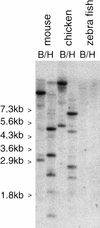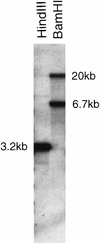Comparative genomic analysis of the interferon/interleukin-10 receptor gene cluster
- PMID: 10077530
- PMCID: PMC310731
Comparative genomic analysis of the interferon/interleukin-10 receptor gene cluster
Abstract
Interferons and interleukin-10 are involved in key aspects of the host defence mechanisms. Human chromosome 21 harbors the interferon/interleukin-10 receptor gene cluster linked to the GART gene. This cluster includes both components of the interferon alpha/beta-receptor (IFNAR1 and IFNAR2) and the second components of the interferon gamma-receptor (IFNGR2) and of the IL-10 receptor (IL10R2). We report here the complete gene content of this GART-cytokine receptor gene cluster and the use of comparative genomic analysis to identify chicken IFNAR1, IFNAR2, and IL10R2. We show that the large-scale structure of this locus is conserved in human and chicken but not in the pufferfish Fugu rubripes. This establishes that the receptor components of these host defense mechanisms were fixed in an ancestor of the amniotes. The extraordinary diversification of the interferon ligand family during the evolution of birds and mammals has therefore occurred in the context of a fixed receptor structure.
Figures








References
-
- Benton MJ. Phylogeny of the major tetrapod groups: Morphological data and divergence dates. J Mol Evol. 1990;30:409–424. - PubMed
-
- Burnside J, Liou SS, Cogburn LA. Molecular cloning of the chicken Growth Hormone Receptor complementary deoxyribonucleic acid: Mutation of the gene in sex-linked dwarf chickens. Endocrinology. 1991;128:3183–3192. - PubMed
-
- Cheng S, Lutfalla G, Uzé G, Chumakov IM, Gardiner K. GART, SON, IFNAR, and CRF2-4 genes cluster on human chromosome 21 and mouse chromosome 16. Mamm Genome. 1993;4:338–342. - PubMed
-
- Digby MR, Lowenthal JW. Cloning and expression of the chicken interferon-gamma gene. J Interferon Cytokine Res. 1995;15:939–945. - PubMed
Publication types
MeSH terms
Substances
Associated data
- Actions
- Actions
- Actions
- Actions
- Actions
- Actions
- Actions
- Actions
- Actions
- Actions
Grants and funding
LinkOut - more resources
Full Text Sources
Other Literature Sources
Molecular Biology Databases
